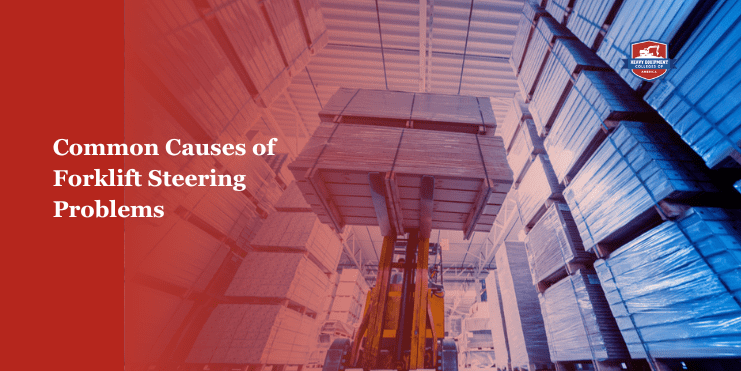Malfunctioning forklift steering is one of the most common problems that forklift operators experience. The steering wheel controls every move of the forklift. When this control center malfunctions, mistakes, and injuries are more likely to occur.
The key to ensuring worker safety is to detect steering issues in their early stages so they can be corrected. Need a guide to becoming a heavy equipment operator? Keep reading for a breakdown of forklift components, common failures, and handy troubleshooting tips.
What Are the Parts of a Forklift Called?
Any forklift operator or maintenance technician should be familiar with the machine’s primary components. Keep in mind that each primary component contains many smaller components that all enable the forklift to function.
- Mast: The mast controls the forklift’s lifting, lowering, and tilting capabilities. It’s connected to the forks—which transport loads—and the carriage—which draws power from a hydraulic piston on the mast.
- Chassis: The chassis contains four major parts—the counterweight, the engine or battery, the operator compartment, and the wheels and tires.
- Overhead Guard: The overhead guard is a safety component that protects the forklift operator from falling objects in the cab portion.
What Are the Most Common Forklift Failures?
Knowing how to address a forklift failure starts with knowing what potential failures you could be dealing with. Here are the top three system failures associated with operated forklifts.
1. Mast Issues
Since forklifts frequently lift loads in multiple stages, the mast is more susceptible to error during operation.
2. Steering Issues
Steering a forklift is no easy task, especially in tight spaces. Various underlying problems can cause the steering mechanism to malfunction, which puts workers at risk of injury.
3. Starting Issues
Sometimes your forklift simply won’t turn on. This start failure decreases productivity, which impacts your bottom line.
WHY CHOOSE HEAVY EQUIPMENT COLLEGES OF AMERICA?
GET TRAINED. GET CERTIFIED. START A CAREER.
Warning Signs for Forklift Steering Problems
Unfortunately, most forklifts give no warning signs when a steering problem occurs. You often won’t know something is wrong until an issue presents itself while you’re operating the machine. All you can do is know what steering problems could occur and how to respond if and when they do.
4 Causes of Malfunctioning Forklift Steering
1. Steering Pressure Valves
Modern forklifts are equipped with steering pressure that operates the hydraulic system along with a valve that controls the steering pressure. This valve can wear down and loosen after many uses, opening the door to steering pressure problems.
2. Worn Gears
If you have to turn the steering wheel extensively to move the forklift just slightly to the right or left, worn gears may be to blame. Gears wear down naturally over time, which is why this problem is common in older forklifts.
3. Low Steering Fluid Levels
Every forklift contains a supply of steering fluid that enables the steering wheel to turn smoothly. When this steering fluid supply diminishes, the steering wheel undergoes excess friction that can deteriorate other internal components.
4. Misaligned Tires
Malfunctioning steering cylinders can cause a forklift’s tires to become misaligned. When the tires misalign, you’ll have trouble steering the machine in the right direction.
Preventative Forklift Maintenance
If you want your forklift to work properly and last for years to come, we recommend following these basic maintenance procedures.
- Perform routine inspections to ensure proper function, enhance efficiency, and avoid financial losses. The maintenance guideline provided by the manufacturer is a good rule of thumb to follow.
- Adequately train forklift operators and designated maintenance technicians to prevent user errors and equipment damage.
- Maintain a supply of replacement parts for forklift components that malfunction or break.
Forklift Steering Troubleshooting Tips
Here are some forklift steering troubleshooting tips you can implement the next time your forklift’s steering mechanism malfunctions.
- Check the hydraulic fluid levels to ensure they’re within the manufacturer’s recommended range
- Inspect the steering components for any noticeable water damage like cracks or corrosion
- Perform a thorough inspection of the forklift’s electrical connections and wiring to detect any damage or corrosion
- Reference the forklift’s service manual for additional troubleshooting tips and diagnostic procedures
Become a Certified Heavy Equipment Operator at HEC
If you want to earn your heavy machinery license, Heavy Equipment Colleges of America (HEC) is the heavy equipment school for you. Most programs can be completed in as little as three weeks. Start the enrollment process today to get one step closer to achieving your career goals.

